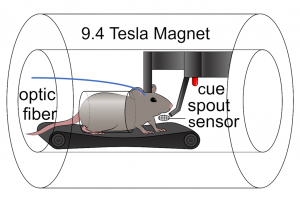Featured Paper of the Month – June 2021
 Published in Communications Biology by Christopher Cover and Hanbing Lu, et al. in the NIDA IRP Magnetic Resonance Imaging and Spectroscopy Section.
Published in Communications Biology by Christopher Cover and Hanbing Lu, et al. in the NIDA IRP Magnetic Resonance Imaging and Spectroscopy Section.
Summary
Functional magnetic resonance imaging (fMRI) can image brain dynamics while a human subject engages in a goal-directed task, it has proven extremely challenging to perform similar studies in rodents due to the difficulty in both limiting motion and mitigating stress during task performance. Herein we report a method that makes this possible: mice are cued to lick a spout to receive optogenetic stimulation. Noninvasive whole brain readout combined with circuit-specific neuromodulation opens an avenue for investigating adaptive behavior in both healthy and disease models.
Publication Information
Whole brain dynamics during optogenetic self-stimulation of the medial prefrontal cortex in mice Journal Article
In: Communications Biology, vol. 4, no. 1, pp. 66, 2021, ISBN: 2399-3642.
